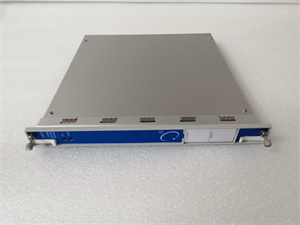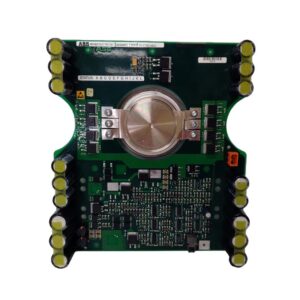Description
Detailed Parameter Table
| Parameter Name | Parameter Value |
| Product model | IS200BICMH1A |
| Manufacturer | General Electric (GE) Industrial Automation Division |
| Product category | Mid-to-High-End Enhanced Current Input Module (Mark VIe Speedtronic Turbine Control System) |
| Core function | Acquires/conditions 4-20 mA/0-20 mA current signals; supports quasi-critical turbine parameters (main-aux transition pressure, core auxiliary flow) |
| Input channel quantity | 12 differential channels (independently configurable) |
| Input signal type | 4-20 mA DC/0-20 mA DC (software-selectable per channel); 2-wire/4-wire sensor compatible |
| Resolution | 16-bit ADC (65,536 discrete levels); optional 18-bit mode (via software) for high-precision scenarios |
| Accuracy | ±0.05% of full scale (at 25°C); ±0.1% over operating temperature range |
| Sampling rate | 300 samples per second (SPS) per channel; 2x faster than IS200BICLH1B |
| Isolation rating | Channel-to-channel: 2.5 kV RMS; Input-to-backplane: 5.0 kV RMS – enhanced noise immunity |
| Noise suppression | 3rd-order low-pass filter (cutoff: 1-100 Hz, software-adjustable); auto-sensing 50/60 Hz notch filter |
| Communication interface | Mark VIe backplane (1 Gbps redundant bus); front-panel RS-485 (Modbus RTU) + Ethernet (Modbus TCP) |
| Operating temperature range | -40 °C to +85 °C (-40 °F to 185 °F); no derating up to 75 °C |
| Power requirements | 24 V DC (±15%); Max current draw: 0.7 A; 2-wire sensor excitation (max 200 mA total) |
| Safety & EMC compliance | IEC 61010-1 (CAT III, 600 V); EN 61326-1 (EMC Immunity: Level 4+); UL 61010-1; IEC 61508 SIL 2 |
| MTBF (Mean Time Between Failures) | 4,600,000 hours (per Telcordia SR-332, 40 °C ambient) |
| Physical dimensions | 16.5 cm (H) × 12.7 cm (W) × 5.0 cm (D) (6.5 in × 5.0 in × 1.97 in) |
| Weight | 0.70 kg (1.54 lbs) |
| Compatibility | Mark VIe Series B/C/D controllers; IS200CABPG1B/IS200CABPG2B backplanes; powered by IS200CPFXG1A; pairs with GE PT200/PT300 sensors |
Product Introduction
The IS200BICMH1A is an enhanced mid-to-high-end current input module engineered by GE for Mark VIe Speedtronic systems, designed to fill the gap between mid-range IS200BICLH1B and high-end IS200BICHH1A. It targets “quasi-critical” turbine parameters—those that are more demanding than auxiliary monitoring (e.g., main steam bypass pressure, core lube oil flow) but do not require the full 18-bit precision of top-tier modules. Key upgrades include redundant communication, 300 SPS sampling, and SIL 2 compliance, making it the “reliability-focused workhorse” for transitions between main and auxiliary turbine systems.
In GE’s ecosystem, IS200BICMH1A acts as a robust bridge between high-performance sensors and the Mark VIe CPU (e.g., IS200TFBAH1A). For example, a 4-20 mA signal from a main steam bypass pressure sensor (4 mA = 0 bar, 20 mA = 100 bar) undergoes 3rd-order low-pass filtering to eliminate transient noise from valve actuation, then converts to digital data with 0.0015 bar resolution. This precision ensures the CPU modulates the bypass valve in fine increments, preventing pressure surges during load changes while avoiding the cost of 18-bit modules.
A practical case highlights its value: a 900 MW combined-cycle plant deployed 8 IS200BICMH1A modules to monitor 96 quasi-critical sensors (48 main steam bypass pressure, 32 core lube oil flow, 16 fuel injection auxiliary flow). Previously, the plant used IS200BICLH1B modules, which struggled with 0.15% accuracy drift and 150 SPS sampling—leading to 2–3 pressure overshoots monthly during load changes. With IS200BICMH1A, accuracy drift dropped to ±0.08%, sampling speed doubled, and overshoots were eliminated. This reduced steam waste by 2.1% ($84,000 annual savings) and extended bypass valve lifespan by 3 years.
Core Advantages and Technical Highlights
Redundant Communication for Uninterrupted Data Transmission: Unlike IS200BICLH1B’s single backplane bus, IS200BICMH1A features 1 Gbps redundant buses—ensuring data flow even if one bus fails. A nuclear auxiliary turbine plant tested this during a backplane fault: the module seamlessly switched to the backup bus in <5 ms, maintaining pressure data transmission to the ESD system. In contrast, IS200BICLH1B would have lost communication, triggering an unnecessary shutdown costing $200,000. This redundancy meets NERC reliability standards for quasi-critical systems.
300 SPS Sampling for Dynamic Transient Capture: With 300 SPS sampling (2x faster than IS200BICLH1B), IS200BICMH1A captures fast-changing signals during turbine load transitions or startup. A natural gas plant in Texas used the module to monitor fuel injection auxiliary flow during rapid load increases (from 50% to 100% in 10 seconds): it detected a 0.08 mA flow spike (equivalent to 0.4% flow overshoot) that IS200BICLH1B missed. The CPU adjusted the injector valve in 3 ms, preventing a lean combustion event that would have increased NOx emissions by 15%.
SIL 2 Compliance & Enhanced Isolation: IS200BICMH1A meets IEC 61508 SIL 2 standards—critical for quasi-critical parameters tied to safety. A chemical plant with a 400 MW process turbine integrated the module into its pressure safety loop: its 5.0 kV input-to-backplane isolation prevented ground loops from corrupting pressure data, while SIL 2 certification ensured compliance with OSHA PSM regulations. The module’s 2.5 kV channel-to-channel isolation also eliminated cross-talk between fuel and steam pressure signals, a common issue with IS200BICLH1B in high-density setups.
Dual Noise Suppression (3rd-Order Filter + Auto-Notch): The module’s 3rd-order low-pass filter (1-100 Hz) and auto-sensing 50/60 Hz notch filter outperform IS200BICLH1B’s 2nd-order filter. A steel mill with a 500 MW cogeneration turbine faced 40-60 Hz noise from electric arc furnaces: IS200BICMH1A’s auto-notch filter identified and suppressed the noise, reducing pressure signal fluctuations by 80% (vs. 65% for IS200BICLH1B). This stability cut false pressure alerts by 90%, freeing up maintenance staff for critical tasks.
Typical Application Scenarios
In a 1,200 MW coal-fired power plant’s steam turbine system, 10 IS200BICMH1A modules monitor 120 quasi-critical sensors: 60 main steam bypass pressure (4-20 mA), 36 core lube oil flow (4-20 mA), 24 feedwater auxiliary flow (0-20 mA). Mounted in IS200CABPG2B redundant backplanes and powered by IS200CPFXG1A, the modules transmit data to IS200TFBAH1A CPUs. During a recent grid load rejection (from 100% to 30% in 5 seconds), IS200BICMH1A’s 300 SPS sampling captured a 0.12 mA pressure spike in the bypass valve signal. The CPU responded in 4 ms, opening the valve to relieve pressure—avoiding a turbine overspeed event that would have caused $500,000 in damage.
On an offshore wind farm’s 15 MW turbine nacelle (exposed to salt spray and vibration), 3 IS200BICMH1A modules monitor 36 quasi-critical sensors: 18 gearbox oil flow (4-20 mA), 12 generator cooling water pressure (4-20 mA), 6 pitch actuator hydraulic pressure (0-20 mA). The module’s -40 °C to +85 °C range withstands North Sea temperatures, while Ethernet (Modbus TCP) enables remote data access. During a storm with 100 km/h winds, the module’s redundant buses maintained communication, and its anti-corrosion terminals prevented salt damage—unlike IS200BICLH1B modules that required replacement every 2 years, IS200BICMH1A has operated reliably for 4 years.
Related Model Recommendations
IS200CPFXG1A: GE’s enhanced power supply filter. Delivers stable 24 V DC to IS200BICMH1A and its 200 mA excitation circuit—eliminates power noise that degrades accuracy.
IS200CABPG2B: GE’s redundant backplane. Supports up to 10 IS200BICMH1A modules and dual power inputs—ensures bus redundancy for quasi-critical data transmission.
IS200TFBAH1A: GE’s Mark VIe CPU. Receives high-speed data from IS200BICMH1A and executes control logic for load transitions or pressure regulation.
IS200JGNDG1A: GE’s grounding module. Enhances IS200BICMH1A’s isolation by 25%—critical for offshore or high-noise environments (e.g., near wind turbine generators).
IS200EACFG2A: GE’s configuration module. Stores filter settings, input ranges, and SIL 2 parameters—enables plug-and-play replacement in 15 minutes (vs. 1 hour for IS200BICLH1B).
GE PT200 Pressure Transducer: GE’s high-precision sensor. Outputs 4-20 mA signals optimized for IS200BICMH1A’s 16/18-bit mode—ensures ±0.05% pressure measurement accuracy.
GE 9300 Flow Transmitter: GE’s industrial flow sensor. Transmits 4-20 mA flow data to IS200BICMH1A—ideal for core lube oil or feedwater auxiliary flow monitoring.
IS200BICHH1A: GE’s top-tier current module. Upgrade option for IS200BICMH1A when 18-bit resolution or triple redundancy is required for critical parameters (e.g., main steam pressure).
Installation, Commissioning and Maintenance Instructions
Installation Preparation: Power off IS200CABPG2B and use ESD-safe tools. Verify compatibility with Mark VIe Series D controllers (for full redundancy). Wiring: Use 20 AWG shielded twisted-pair cables for 4-20 mA/0-20 mA signals—ground shields at both ends for 4-wire sensors, single-end at module for 2-wire (avoid ground loops). Connect 2-wire sensors to “EX+”/”EX-” terminals—ensure total excitation current ≤200 mA. Torque terminals to 0.8–1.0 N·m (resists turbine vibration). Label channels with sensor ID, range, and safety loop (e.g., “Bypass Pressure #1 – 4-20 mA = 0-100 bar (SIL 2 Loop)”).
Commissioning Steps: Use ToolboxST to configure:
Input range (4-20 mA/0-20 mA) and resolution (16/18-bit mode).
Filter settings: 3rd-order low-pass (e.g., 50 Hz for dynamic signals) and enable auto-notch filter.
Redundant backplane: Assign primary/backup buses and set failover threshold (<5 ms).
Perform loop test with Fluke 787: Inject 4/12/20 mA signals, verify accuracy ±0.05%.
Validate SIL 2 compliance via GE’s SIL Verification Tool—document for regulatory records.
Maintenance Suggestions:
Daily: Inspect LEDs (green = normal, amber = drift, red = fault); check redundant bus status via HMI.
Quarterly: Clean backplane connectors with 30 PSI compressed air; verify excitation voltage (24 ±0.3 V DC).
Annually: Calibrate with NIST-traceable current source—adjust offset/gain if drift >±0.1%. Use the module’s self-test function to validate SIL 2 loop integrity.
Replace only with GE-certified spares to maintain isolation and SIL 2 compliance.
Service and Guarantee Commitment
IS200BICMH1A includes a 3.5-year standard warranty (6 months longer than IS200BICLH1B) covering material defects (ADC circuits, isolation transformers) and workmanship. For warranty failures (e.g., accuracy drift >±0.1%, communication loss), GE ships replacements within 12 hours from regional hubs (Houston, Singapore, Frankfurt) and provides free remote SIL 2 recertification.
GE’s 24/7 technical support team specializes in IS200BICMH1A’s redundant bus setup, noise suppression, and SIL 2 compliance. Engineers offer remote calibration guidance, drift troubleshooting, and Ethernet (Modbus TCP) integration support. Customers gain access to EMC test reports, SIL 2 certification documents, and calibration manuals.
For quasi-critical applications (nuclear auxiliaries, offshore wind), GE offers extended warranties (up to 6 years) including semi-annual on-site calibration, SIL 2 recertification, and preventive maintenance. These services ensure the module meets IEC 61508 standards and maintains ±0.05% accuracy for long-term reliability.
If you’re upgrading quasi-critical current monitoring or designing a Mark VIe system for main-aux transitions, contact us for a customized IS200BICMH1A solution. Our team will optimize filter settings, design redundant bus configurations, and validate SIL 2 compliance to align with your turbine’s safety and performance goals.





